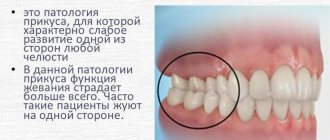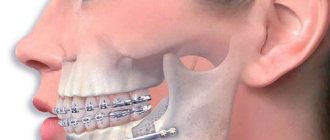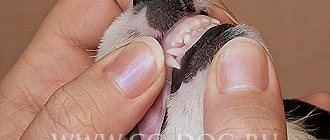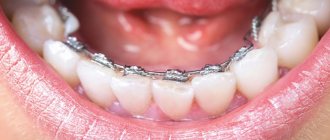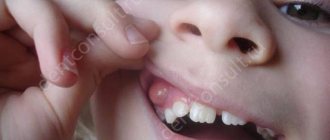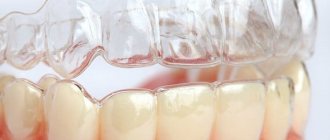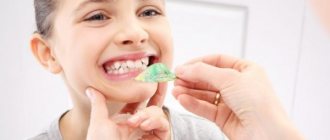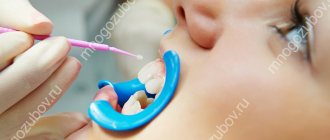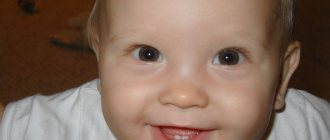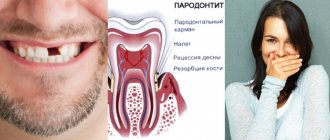11075
Malocclusion is a fairly common phenomenon that can be confidently interpreted as a diagnosis.
These are not only external defects of the maxillofacial apparatus, but also pathologies that cause certain harm to human health.
At the same time, there are often cases when the harm goes beyond the dental framework - difficulty chewing food leads to dysfunction of the gastric system.
One of these bite deviations is a pronounced defect in the development of the jaw. It manifests itself both in its size and in insufficient width or fragmented crowding of the dentition.
Definition
The concept of “small lower jaw” in orthodontics is not clearly defined.
This diagnosis is classified into several types, differing in the clinical picture of the anomaly.
Micrognathia
Mandibular micrognathia is a defective or too long-term development of an organ that goes beyond the norm.
The defect can affect both the entire jaw and its individual areas, for example, affecting only one lateral part.
Prognathia
It is considered a phenomenon directly opposite to the case described above.
The organ corresponds to the normal parameters, but with the pronounced size of the upper jaw, it seems that it is too small.
Experts often call this disease false prognathia.
General overview
The narrowing of the dentition is a violation of its shape. Normally, it looks like an ellipse (top row) or parabola (bottom row). All other forms of jaw arches are an anomaly.
From a geometric point of view, the narrowing of the row is characterized by a reduced transverse size of the jaw arch. The narrowing can be bilateral or unilateral. The consequence is a decrease in the width and increase in the depth of the palate, and impaired closure.
Most often, the anomaly is observed in the upper jaw. This is due to the structural features and density of the bone. It is looser than that of the lower jaw.
The defect leads to problems not only of the dentofacial apparatus, but also of other human systems:
- to breathing problems due to the reduced volume of the nasal cavity;
- deterioration of diction - mainly due to limited space for the tongue;
- to digestive problems due to poor chewing of food due to occlusion.
Signs
The main sign indicating the presence of this disease is the visual observability of an anomaly - such a defect is visible to the naked eye, and you do not need to be a specialist in orthodontics to determine such a deviation in a person.
In addition, pathology deforms the natural proportions of the maxillofacial apparatus. The chin becomes sharp and slightly raised upward. Doctors even defined this phenomenon as “bird beard.”
It is important to understand that this is not just a cosmetic defect; micrognathia threatens its “owner” with the development of the pathology of tongue retraction, which is considered a serious disease.
The anomaly causes frequent uncontrollable attacks of suffocation and poses a serious threat to the patient's life.
The disease is often diagnosed based on this characteristic feature - excessive retraction of the chin leads to wrinkling of the skin in its area, and the horizontal fold between the chin and lip is smoothed out.
In addition, underdevelopment of the lower jaw often goes hand in hand with chromosomal mutation processes, which leads to Patau syndrome.
A clear sign indicating the presence of this defect is also the incorrect location of individual fragments of the dentition.
In the case when some organs are missing, neighboring teeth change the direction of growth, trying to spontaneously fill the free space.
Fixed appliance for expanding the upper jaw
Before resorting to surgical treatment (surgery), for micrognathia, an apparatus for expanding the upper jaw is indicated. In most cases, such devices are non-removable and require long-term wearing. However, with their help you can achieve a significant effect (with the exception of severe pathologies). The purpose of their installation is to shift the dentition to the sides from the center of the hard palate. This occurs due to the mechanical load exerted by the expanders.
Which fixed appliance to expand the upper jaw should I choose? Today in orthodontics there are a huge number of different expander devices. The most commonly used in orthodontics are:
- Fixed device for expansion of the upper jaw of Derichsweiler . It consists of rings that are fixed on the molars and connected to each other by arches. In the center of the arches there is a screw with which the tension is adjusted. As a result of the pressure that the device puts on the teeth, the palatal suture diverges and is filled with new bone tissue.
- Cross-shaped palatal expander - operates on the same principle as the fixed Derichsweiler apparatus.
- Fixed expansion plate.
- Springs are additional structures to the above devices.
Causes
This type of anomaly can be triggered by the following factors, some of which are external, and some are internal:
- unbalanced diet of a woman during pregnancy - in this situation, the defect is formed already at the stage of intrauterine development of the fetus;
- chromosomal mutations that cause deviations in the normal growth and development of the baby during pregnancy;
- genetic predisposition;
- Robin's syndrome is a congenital anomaly of the anatomical structure of the facial apparatus;
- too early loss of baby teeth or permanent organs in adulthood , as well as a fairly long change from a temporary bite to a permanent one;
- difficulty breathing through the nose , associated with the structure of the nasal septum or chronic diseases of the nasopharynx;
- mechanical organ injury.
Everything about correct orthognathic occlusion, its signs and characteristics.
Let's talk here about the treatment of dental dystopia.
Follow the link https://orto-info.ru/zubocheliustnye-anomalii/okklyuzii/glubokiy-prikus.html if you are interested in methods of treating deep bites in adults and children.
Treatment
Methods for eliminating micrognathia depend on the degree of development of the pathology, the age of the patient and can be gentle or radical.
In the first case, treatment is carried out gradually through the use of special bite-leveling structures, and in the second, surgeons are involved in the work.
In children
In childhood, this deviation is easy and in most cases, successfully, treated mainly with therapeutic methods, and with rare exceptions, surgically:
- sanitation of the oral cavity – complete restoration of damaged tooth segments, as well as removal of affected root areas. Restoring the integrity of periodontal tissues using general and targeted spectrum agents;
- pediatric prosthetics – indicated for early loss of mammary organs. The voids are filled by splinting or attaching temporary devices that maintain the correct position of growing teeth and correct the size of the jaw arch;
- correction of language function and normalization of the respiratory system - in the first case, this is surgical cutting of the frenulum, which is done quickly and almost painlessly. In the second - surgical alignment of the partitions, followed by rehabilitation exercises;
- myogymnastics – tonic effect on the muscle tissue of the organ through special gymnastic exercises.
It is advisable to carry out with children 4–6 years of age, when in case of underdeveloped pathology this method can be used as the main method of treating the defect.With positive dynamics, the need for subsequent installation of orthopedic structures, as a rule, no longer arises;
- leveling the unevenness of the chewing surface using the method of grinding (fissures) - an ideal solution for a slight deviation in jaw closure;
- the use of leveling systems and structures is carried out when the anomaly is too pronounced, when other correction methods are ineffective. Wearing mouth guards and plates, and in infancy special nipples, gradually brings the deviation back to normal.
In adults
Treatment of patients whose bite has already been formed takes longer, and methods for correcting it are most often more radical.
Bone grafting
The essence of the method comes down to artificial extension using a graft. Bone tissue is taken from other areas of the patient’s tissue, which guarantees good survival of the material.
Fixation of the grafted fragments is carried out using screws made of high-quality, durable alloy of titanium components. This is done as follows:
- the lower organ is incised;
- the hard tissue is moved apart and the osteoplast is immersed inside;
- fixed with screws;
- intermediate voids are filled with special plastic chips;
- implantation of the membrane and suturing of the organ.
The main advantages of the method are the rapid survival rate and reliability of the procedure; the jaw augmented in this way retains its functionality for many years.
Disadvantage: individual intolerance to components and osteoplast fixatives.
In the video, watch the process of bone grafting for anomalies of the lower jaw.
Bone grafting plus liposculpture
Plastic surgery of hard bone tissue is carried out similarly to the option described above, with the difference that in parallel, aspiration of the local accumulation of fatty tissue is carried out using a vacuum method.
The technique qualitatively solves the aesthetic problem of underdeveloped chin caused by this pathology, corrects its shape, evens out the oval of the face and, in a sense, resembles the effect obtained from lifting the chin area.
The advantage is a high aesthetic result, the disadvantage is the high cost of the procedure and the presence of a large number of contraindications to its implementation.
Causes of open bite development and its dangerous consequences.
In this article we will discuss treatment methods for microdentia.
At this address https://orto-info.ru/zubocheliustnye-anomalii/ryadov/suzhenie.html we offer details about the treatment of narrowing of the dentition.
Endoprosthetics
It is made with harmless facial implants from non-biological components - silicone, porous polyethylene or cartilage extract. The desired shape is given to the device directly during the operation.
The implant is inserted through deep incisions in the mucous cavity, which leaves no postoperative traces. The product is inserted into the subperiosteum in lateral fragments into the chin area and attached to it with surgical sutures to fix its position.
The disadvantage of this method is the rather long recovery period.
Lipofilling
This option is considered to be a non-surgical correction, which is its main advantage.
The method allows you to give the chin the desired shape through pinpoint needle injection of fat cells into the subcutaneous area, in those areas where an increase in the size of the chin is required.
The entire procedure takes no more than an hour. The rehabilitation period passes quickly and without complications. The only drawback is that 30% of the implanted tissue fragments are rejected by the body, which requires repeated lipofilling 5-6 months after the first procedure.
To learn how chin augmentation is performed using lipofilling, watch the video.
Treatment of malocclusion in children
Treatment of pathology with radical methods involves installing braces and wearing orthopedic structures (mouth guards, plates). With their help you can straighten your teeth. You can also use a device to correct bites in children - a trainer. It is selected depending on the age of the child.
Up to 2 years of age, children are given anatomical attachments on their bottles that are shaped like a nipple. They vary depending on the type of food, size, number of holes and age of the child. Based on the diameter of the holes there are:
- L - nozzle with a wide hole for purees or thick soups;
- M - a medium-sized hole through which liquid porridge or milk mixture passes;
- S - with a small hole for juices and milk.
For children over 4 years old, the bite can be corrected with vestibular shields. With their help, they strengthen muscles and get rid of bad habits (sucking fingers or household objects). The shield fits tightly to the surface of the teeth and improves the degree of their closure.
Oral shields are installed for children over 5 years of age. The simulator returns the normal position of the tongue, prevents the jaw from moving forward and helps to relax the muscle tissue.
Children over 7 years old are fitted with passive dental appliances. They consist of several parts:
- an arch made of metal (for the front teeth);
- clasps (retaining and supporting elements);
- springs (located in the middle part);
- base (made of plastic).
The principle of operation of this device is based on the ability to expand the upper jaw and stimulate the growth of its apical base.
The Klammt device will help correct mesial or distal occlusion. It promotes protraction of the lower jaw and tilting of the lower canines in the desired direction. If the child does not have incisors, the device is not installed.
Prices
The approximate cost of treating a defect of abnormal development of the lower jaw is given in the table:
| Character of the bite | Correction method | Average price (in rubles) |
| Lactic | Sanitation of the oral cavity | From 3 500 |
| Lactic | Orthopedic therapy | From 30 000 |
| Lactic | Fissure grinding | From 11 000 |
| Lactic | Operation | From 15 000 |
| Constant | Bone grafting | From 19 000 |
| Constant | Bone grafting pole liposculpture | From 50 000 |
| Constant | Endoprosthetics | From 40 000 |
| Constant | Lipofilign | From 35 000 |
Prevention
In some cases, the development of such a defect can be completely avoided by following the following recommendations:
- preference should be given to breastfeeding , and if this is not possible, control the hole on the nipple - it should not be large in size;
- it is necessary to choose the right pacifier so that its position does not put constant pressure on the weak bone tissue of the gums;
- timely treatment of dental diseases.
